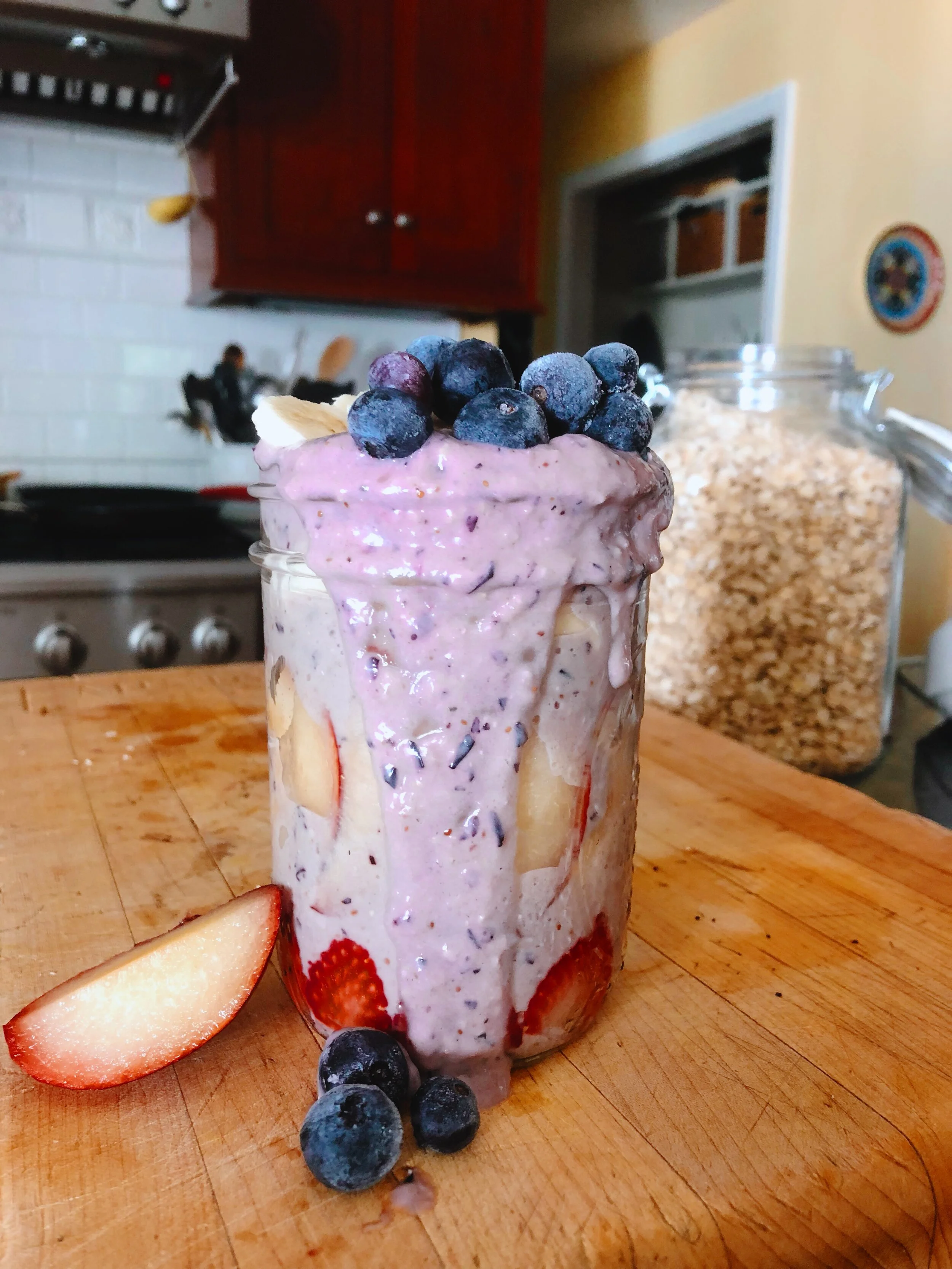The Perfect Smoothie: 8 Things to Keep in Your Pantry for Nutrient-dense Smoothies
Smoothies— easy, quick, always delicious… if you’re buying one from a gourmet health foods store downtown. Don’t feel bad if your smoothies aren’t coming out like the $10 12-oz. ones you'‘re used to buying. Just check out the 8 simple ingredients that you can always keep on hand to ensure that your smoothies are coming out delicious, and nutrient-dense every time.
1. Fruit
Strawberry
Banana
Berries (blueberries, raspberries, blackberries, etc.)
Peach
Pineapple
Mango
Melon
In a typical smoothie, fruit is going to make up the majority of the ingredients because they are juicy, nutrient-and fiber-dense, and have a natural sweetness. My go-to fruit choices are strawberries, bananas and blueberries. Why? I just love this combination and I typically go for fruits that are seedless or have small, soft seeds. For a little more mouthfeel, plus more insoluble fiber, go for the classic seed-y fruits, like raspberries and blackberries. Bananas typically make up the bulk of my smoothies because they’re sweet and mild, so they complement pretty much any flavor (berry, chocolate and peanut butter, vanilla, greens, etc).
2. Vegetables
Carrot
Celery
Spinach
Kale
Cucumber
Pumpkin
Sweet potato
Mild-tasting vegetables are great additions in smoothies. Green smoothies benefit from mild greens like blanched or massaged kale and spinach, both of which contain nutrients like folate, vitamins A and K, and other antioxidants, such as vitamins E and C.
Here are some tips for veggie-based smoothies:
Not all green smoothies have to taste like grass. To compliment those earthy tones, add cucumber, half of a banana, plus a bit of local honey for some sweetness.
If adding veggies to a fruit smoothie, go for vegetables like roasted sweet potato, squash/pumpkin, and beets. By roasting these beforehand, you’ll caramelize their naturally occurring sugars, making them taste even sweeter than they would if they were raw. You’ll be shocked by the flavors these veggies bring to a smoothie.
Are your taste buds overwhelmed by the earthy tones in your veggie smoothies? Try working on your fruit to vegetable ratio. Start by making your smoothies with 2-or 3-parts fruit to 1-part vegetables (2 or 3:1). This way, the vegetable flavors will be masked by the sweetness in the fruit.
3. Protein
Collagen peptides
Dairy (Greek yogurt, milk, kefir, plant-based options)
Oat flour (5 grams per 1/2 cup serving— check out my post on the benefits of oats and oat flour)
Silken tofu
Branched-chain amino acids (BCAA’s)
4. Fat
Nuts & seeds (hemp, flax, chia, and nut butters like peanut, cashew, almond, and sunflower)
Avocado
Coconut oil
Making smoothies with added protein and fat is going to be essential in keeping you full and satisfied, especially if you’re replacing a full, solid meal or snack with a smoothie. Adding a fat source also contributes to a smooth and creamy mouthfeel. I’ll typically add a scoop or two scoops of marine or bovine collagen peptides to my smoothies for extra protein. My fat typically comes from adding ¼-1/2 avocado, whole cow’s milk, or a tablespoon of coconut oil.
5. Liquid base
Cow’s milk
Plant-based beverages (hemp milk, soy milk, almond milk, cashew milk, oat milk)
Water
Unless you’re going for a thick “nice”-cream consistency, you’ll want to add some sort of liquid. I’ll typically go half and half with water and some sort of milk or plant-based beverage. Hemp milk has the highest protein content of the few I listed above, but all plant-based beverages make for a great addition. You can also easily make these at home!
6. Spices
Vanilla extract
Turmeric + black pepper
Cinnamon
Nutmeg
Fresh ginger
Spices are essential for maximizing flavor and functionality of smoothies. Enhancements like vanilla, cinnamon, and ginger can upgrade the flavor of a smoothie instantly. One of my favorite combinations is turmeric and a little bit of black pepper because of the naturally occurring anti-inflammatory properties created when pairing the two together. The compounds in black pepper allow the body to better absorb the curcumin, which is the anti-inflammatory compound in turmeric, making it more bioavailable. Don’t worry about making a spicy smoothie when you combine the two. Turmeric has nutty, earthy tones that pair well with sweet ingredients, and you’ll barely be able to detect the black pepper. I’ve come across a few different turmeric and black pepper tincture recipes that have a turmeric to black pepper ratio of 10-or 20 to 1 (20-parts turmeric to 1-part black pepper).
7. Sweetener
Honey
Maple Syrup
Sugar
Agave nectar
When I’m craving something sweet and refreshing, berry smoothies with a bit of honey or maple syrup hit the spot. Local honey is a great option for sweetening, though the jury is still out on whether or not consuming local honey improves the body’s immune response to airborne irritants and allergens like pollen. Either way, consuming locally grown and harvested products must be beneficial in some way, apart from benefiting the environment in terms of minimizing carbon dioxide emissions, right?
8. Something left over
Roasted beets
Sautéed spinach
Sweet potato/Japanese sweet potato
I’m ALL for using up my leftovers. If I think it might taste good in a smoothie, it’s going in a smoothie. I’ve used all three of the options I listed above, most recently being baked sweet potato discs. They were lightly seasoned with salt and black pepper, but I threw a bit of turmeric powder in there and called it a day. If anything, the savory notes enhanced the sweetness of the fruit and leftover potato and resulted in a delicious and nutritious smoothie.
So, there you go folks! As long as you have a few of the ingredients listed above, you’re on track for making some delicious smoothie recipes. Happy blending!

